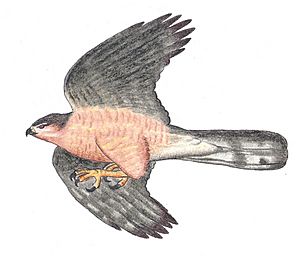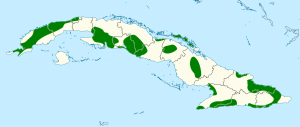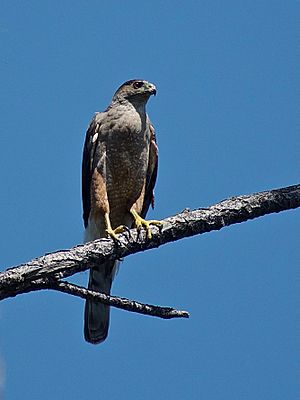Gundlach's hawk facts for kids
Quick facts for kids Gundlach's hawk |
|
|---|---|
 |
|
| Conservation status | |
| Scientific classification | |
| Genus: |
Accipiter
|
| Species: |
gundlachi
|
| Subspecies | |
|
|
 |
|
| Synonyms | |
|
Accipiter gundlachii Lawrence, 1860 [orth. error] |
|
The Gundlach's hawk (Accipiter gundlachi) is a special type of bird of prey that lives only in Cuba. It belongs to the Accipitridae family, which includes many hawks and eagles. This hawk is one of 21 bird species that are endemic to Cuba, meaning they are found nowhere else in the world. It was named after Juan Cristobal Christoff Gundlach, a famous German-Cuban scientist who studied birds. Sadly, this amazing bird is currently in danger because it is losing its home and is sometimes hunted by people.
Contents
What Does the Gundlach's Hawk Look Like?
The Gundlach's hawk is a medium-sized bird that lives in forests. It stands about 43 to 51 centimeters (17 to 20 inches) tall. This hawk has a strong, sturdy body.
Adult hawks have dark bluish-gray feathers on their upper body and wings. Their head is black, and their belly is a lighter color. They also have a striped tail that looks rounded when they fly.
Younger hawks look a bit different. They are mostly brown on top and lighter underneath. They also have dark streaks running down their body. Compared to some other hawks, the Gundlach's hawk is shorter and can fly faster.
How Do Gundlach's Hawks Behave?
Reproduction and Nesting Habits
Gundlach's hawks usually build their nests high up in forest trees. They often choose tall pines, placing their nests about 19 to 25 meters (62 to 82 feet) off the ground. Building nests so high helps them hunt other birds that nest lower down. It also helps protect their young from predators. This high nesting behavior is common for hawks in the Accipiter group. Their nests are typically made from small twigs found in their forest home.
What Do Gundlach's Hawks Eat?
These hawks mostly eat other birds. They have large feet, which helps them catch bigger birds. Their diet can include the Cuban Parrot, the Cuban Parakeet, and even the Cuban Macaw (before it became extinct). They also hunt doves, pigeons, quail, and even chickens.
How Do Gundlach's Hawks Communicate?
Gundlach's hawks have two main calls: a "kek" sound and a "squeal." These calls are typical for hawks of their type, Accipiter. The sounds they make are different for males and females. They vary in how high or low the sound is (pitch), how fast they call (tempo), and how long the call lasts. Male hawks make softer, clearer, and higher-pitched calls. Females make most of the calls, and their calls are usually at a lower pitch.
Where Do Gundlach's Hawks Live?
The Gundlach's hawk is found only on the island of Cuba. They used to be common all over the country. However, now you can only find them in five separate areas. Most of these hawks live in the eastern part of the island, in two larger groups. The other three smaller groups are found on the western side of Cuba.
These hawks can live in different types of forests, up to 800 meters (2,600 feet) high. This includes humid forests, dry forests, and pine forests. They don't need a very specific type of habitat. They just need forests to hide in while they hunt. Their natural homes are dry forests and lowland moist forests.
What Is Being Done to Protect Gundlach's Hawks?
Conservation Status and Efforts
Since 1994, the Gundlach's hawk has been listed as an endangered species. This is because there are only a few of them, and their groups are spread out. However, in the last five years, the number of hawks seems to have stopped decreasing.
Experts believe there are about 400 Gundlach's hawks in Cuba, with around 270 adult birds. Because their numbers are stable, they might be reclassified as "vulnerable" instead of "endangered" soon. This improvement might be thanks to conservation efforts. These efforts include public campaigns to raise awareness about the hawk and teaching people about its needs. More studies are needed in Cuba to truly understand the hawk's current situation and future.
Threats to Gundlach's Hawks
The Gundlach's hawk faces a major threat: loss of habitat. This happens because of deforestation (cutting down forests) and logging in Cuba. These hawks need trees not only for building nests but also for hiding when they hunt other birds. Another problem is that farmers sometimes hunt the hawks. This happens because the hawks like to eat poultry, like chickens, which can cause problems for farmers.
See also
 In Spanish: Gavilán cubano para niños
In Spanish: Gavilán cubano para niños



